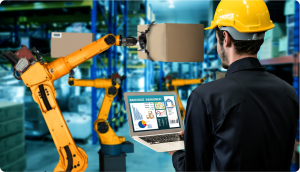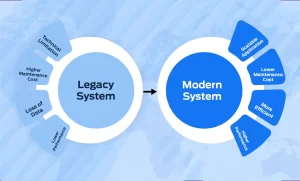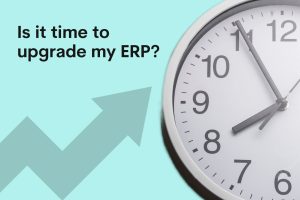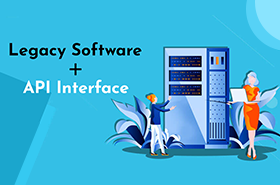
Over the years, one generation of software and hardware has had to give away to the next. Businesses are faced with the dilemma at regular intervals – to do or not to do a technology modernization. The question is when do they reach this point and what should they do.
It is not always easy to go with the option of “Off with the old and on with the new” for the simple reason that the existing system is well entrenched and a change could affect business continuity. Of course, the other reason is the fact that a completely new system can come at a very high cost. So what is a business to do?
Is it possible to modernize software in its place?
This could be the easiest option for business leaders – who want a better user experience and improved efficiency but they want IT partners or in-house teams to deliver a solution quickly. However, there are only a few use cases where legacy applications can be modernized in place.
- If you have an on-premise mainframe system
- You don’t want to make ANY changes only move your software to the cloud
1.If your company wants to modernize its Mainframes
Some businesses still use Mainframes. Until the mid-1990s, Mainframes were the only way for large corporations to handle their data processing requirements. In fact, even today, Mainframes are still used because of their security and reliability by industries such as banking, government institutions, insurance, and other public enterprises.
For example, a bank can use a mainframe to store a database of all its customer accounts in a safe and secure way. Yet transactions can be submitted from anywhere in the world through any ATM worldwide This is why companies like IBM still sell mainframes and we know they are not a legacy software company. They are on the cutting edge of innovation. This is because Mainframes are still going strong after 70 years.
So if you are looking at modernizing your organization’s Mainframe, modern mainframe technology allows the software to be reworked and made more modern while still using the same framework.
2. Companies who want a “lift and shift” migration of existing software to the cloud
This is applicable to a company that uses many custom-built legacy applications and does not want to change them. They want to shift their systems from on-premise to the cloud. You might think that this applies only to large corporations with complex applications. However, in our experience, clinicians and private practices in America do not want to change their Legacy EHR systems that are built for desktops but must still interface with other healthcare organizations. In such cases building an interface layer to the cloud through APIs could be a workable solution. Check out how iTech delivered for a customer in this situation.
In the lift and shift migration method of software reengineering; applications, data, and workflows are copied from the on-premise infrastructure and moved without change to the cloud platform. There is NO change in the software or architecture. This means that your software is not using any modern technology except for now being available on the cloud. It might not be right for every situation.
For those businesses who need to leverage modern innovation while using their same business logic, refactoring and re-platforming are the processes they need to choose.
What is the meaning of software reengineering?
Software reengineering of legacy applications refers to the process of making gradual improvements to modernize software to meet current business needs while preserving as much of the existing legacy functionality as possible.
Soft reengineering is often used when a complete rewrite of the system is not feasible or cost-effective, but incremental improvements are still necessary to meet changing business requirements or to address issues with the existing system. By taking a gradual approach to improving the system, soft reengineering can help to minimize disruption to users and ensure that the system remains reliable and stable throughout the process.

Refactoring and re-platforming are two different approaches to software reengineering
To explain the difference between refactoring and re-platforming, let us compare it to fixing an old car. One way would be to only fix the worn-out parts. That would mean it would visually look like the same car but with some fresh details. This is refactoring.
We could strip the car down and then replace its engine with a newer model. At the same time, we could replace its suspension and transmission. We could even make it CNG powered, changing it from the old petrol-powered model (changing the architectural framework). This is re-engineering the car using a re-platforming process.
Now taking refactoring and re-platforming from a car to software:
Code refactoring is the process of restructuring existing code without changing its external behavior. The goal of refactoring is to improve the design and maintainability of the software system. This can involve activities such as
- Simplifying complex code, could also include rewriting legacy code using a more modern programming language.
- Removing duplication in code or unused code that builds over years.
- Modularizing components. Modularizing involves splitting code into smaller parts. A modular architecture, also known as microservices, breaks down an extensive, complex program into sub-programs. Each interacts with other components through APIs but can be functionally improved at any time without affecting any other component.
Code refactoring is typically done incrementally, and the goal is to make small changes that improve the code quality and rarely introduce new functionality.
Re-platforming, on the other hand, involves moving an existing software system to a new platform or technology stack. This can involve completely rewriting the system, or making significant changes to the existing code base. The goal of re-platforming is often to modernize the system and take advantage of new capabilities and features available on the new platform. Re-platforming can also involve migrating data and configurations to the new system, and training users and administrators on the new platform.
Both refactoring and re-platforming can be used to improve the quality and maintainability of software systems, but they differ in their approach and goals. Refactoring is typically used to make small improvements to an existing system, while re-platforming involves significant changes to the system architecture and technology stack. The choice between these approaches will depend on factors such as the age and complexity of the existing system, the availability of resources and expertise, and the business needs and goals of the organization.
When is the right time to modernize software?
That is a difficult decision made easier if your business systems are not using APIs to exchange information with other enterprise applications. Digital networks are important for most use cases. In today’s environment, automation is mission-critical for improving the efficiency of business workflows.
The basis to make this decision to modernize software should be through an audit of your existing software on 3 parameters – business, technical and operational perspectives.
A well-thought-out blend of strategies is what iTech legacy modernization experts recommend. You could lift and shift some software applications. Refactor other apps and discard legacy applications in favor of SaaS solutions if applicable. Contact us to get our top team of experts to discuss what are the possible solutions based on your insights.









